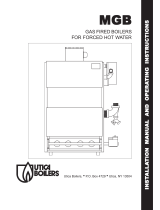
4
IMPORTANT FACTS ABOUT YOUR NEW BOILER
Your boiler must have air for combustion and ventilation. Do not enclose in an airtight room or enclosure.
To minimize the possibility of serious personal injury, fire, damage to your boiler, or improper operation, carefully follow these safety
rules:
1. Keep the area around your boiler free of combustible materials, gasoline, and other flammable liquids and vapors. (Fig 8)
7 8
2. Do not cover the boiler, store trash or debris near it, or in any way block the flow of fresh air to the unit. (Fig 7)
3. A boiler installed in an insulated space must be kept free and clear of insulating material. Examine the boiler area when installing
or adding more insulation. Some materials may be combustible.
4. Combustion air must be clean and uncontaminated with chlorine or flourine (halogenated hydrocarbons). These compounds are
present in many products around the home such as water softener salts, laundry bleaches, detergents, adhesives, paints, varnishes,
paint strippers, waxes, and plastics.
Make sure the combustion air for your boiler does not contain any of these compounds. Keep containers tightly closed. During
remodeling or construction, be sure the air around your boiler is fresh and uncontaminated. If these compounds are burned in your
boiler, the sections and metal vent system may deteriorate.
5. Improper installation, adjustment, alteration, service, maintenance, or use can cause carbon monoxide poisoning, explosion, fire,
6. Do not use this appliance if any part has been under water. Immediately call a qualified service technician to inspect the appliance
and to replace any part of the control system and any gas control which has been under water.
electric shock, or other occurrences which may injure you or damage your property. Consult a qualified installer, service agency, or
the gas supplier for information or assistance.
STARTING YOUR BOILER
Your boiler is equipped with 1 of the 2 following types of gas control systems:
1.
The manual ignition system has a continuously burning pilot flame. This pilot is manually ignited with a match and continues to
burn.
2.
The automatic intermittent system does not have a continuously burning pilot flame. This pilot is automatically lit by an electric
sparking device each time the thermostat “calls for heat.”
Follow these important safeguards:
1. Never attempt to manually light the pilot on a boiler that has an intermittent ignition system with a match or other source of flame.
2. Read and follow the lighting instructions on the rating plate (located on the right side of the boiler), especially the item that reads
as follows:
Wait 5 minutes to clear out any gas. Then smell for gas, including near the floor, If you smell gas, STOP! Follow “B” in the safety
information located on the boiler access door. If you don’t smell gas, go to the next step.
3. If a suspected malfunction occurs with your gas control system, such as the pilot does not light when it should, refer to the shutdown
procedures in the next section to turn off your system, then call your dealer as soon as possible.
MANUAL PILOT IGNITION
1. Set room thermostat to the lowest temperature setting. (Fig 9)
2. Turn the electrical supply to the boiler to OFF. (Fig 10)
3. Remove burner access door. (Fig 11)
WARNING: Should overheating occur, or the gas valve fail to shut off the gas supply, turn off the manual gas valve
to the boiler BEFORE turning off the electrical supply.
!













